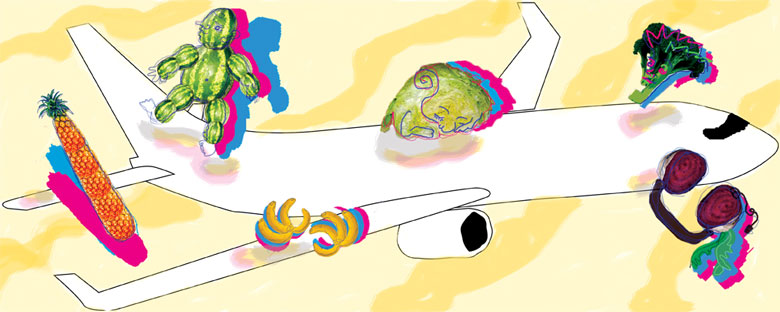
Transatlantic Fine Dining
How Trading with Europe Can Make Canada More Sustainable
by Michelle Pucci
 Graphic by Madeleine Gendreau
Graphic by Madeleine Gendreau
French cheese, Italian wine, and Spanish jamón make up a basic European diet, right?
While Canadian cuisine pales in comparison to some of Europe’s food capitals, ongoing negotiations to open trade between the two may see more delicacies like Polish vodka in Canadian stores.
The Canada-European Union free trade agreement (officially known as the Comprehensive Economic and Trade Agreement) will loosen some restrictions on trade for both parties. Canadians can expect a bit more French cheese on market shelves.
But the issues are complicated for agricultural industries in Canada and Europe, which are both heavily subsidized by governments.
Big dairy companies in Quebec are worried about European cheeses overriding their market—and with good reason. Some regions in Europe are so renowned for their food they have rights over their names (think champagne and feta).
In the EU, cheese produced outside of Parma can’t be called Parmesan—a regulation that doesn’t exist here. Instead, trademark law guides Canadian products, like Maple Leaf’s Parma ham.
The new trade agreement won’t take away from Canadian producers already using these regional names. However, it will force new cheese makers to call their products “feta-style” or even parmesan but not parmigiano-reggiano.
Amy Verdun, an expert on European policy from the University of Victoria, says this might not hurt local dairy producers in places like Quebec as much as they think. It’s expected the amount of cheese imported from the EU will rise from 5 per cent to 9 per cent.
But in a world where buying local is becoming increasingly important, local producers are still in demand. “It offers smaller farmers the opportunity to produce differently and in tune with local consumers,” Verdun said. “They could even be a little more expensive and people would be happy to buy it.”
The Canada-EU agreement doesn’t come without other faults—issues like public procurement and controversial conflict resolution courts are another discussion altogether—but this time Canada has the chance to help define a new kind of free trade and avoid repeating the mistakes of the North American Free Trade Agreement, which devastated Mexico’s vulnerable economy.
“Because of the changes in investment laws, issues around safety standards and tariffs, you had a situation where a lot of the feed was being produced in the United States, pork was being raised in Mexico, cattle in Canada and then they ship it back to the United States for slaughtering,” said Karen Hansen Kuhn of the Institute for Agriculture and Trade Policy earlier this year.
“All of this was facilitated by NAFTA, so in the process the bargaining power of farmers goes down a lot.”
Cooperating with Europe can force Canada to ease off its dependency on the US, which buys most of Canada’s products.
“If we’re open to the U.S. we get all the Monsanto problems, their big agriculture and the way Americans do things,” said Verdun.
“If we open ourselves up to the European Union, we get complaints about oil sands and seals, organic food, fair trade and GMOs,” she said. “Their way of looking at issues around food is not your standard US way.”
Introducing more European products might also break Quebec’s linguistic isolation—importing more foreign goods makes translation laws less contentious.
Holding Canada Accountable
On a global scale, Canada’s leadership in adapting sustainable models has largely fallen apart. Notable shortcomings include the government’s poor progress on its Copenhagen target, where it promised to cut greenhouse gas emissions by 17 per cent, dropping out of Kyoto and skipping the UN’s climate change conference this fall.
Across the Atlantic, European countries have been at the forefront of renewable and efficient energy initiatives. With respect to environmental issues, the initiative to bring Canada closer to the EU through a free trade agreement can only put more pressure on Canada to live up to its promises, according to policy researchers like Verdun.
Even China surprised some critics through the China-US climate pact, where it agreed to derive 20 per cent of its energy from renewable sources by 2020. The US upgraded its targets as well.
If there’s something Canada can take away from a free trade agreement with the EU, it’s their commitment to new energy sources.